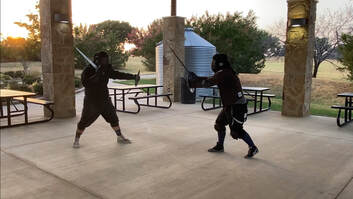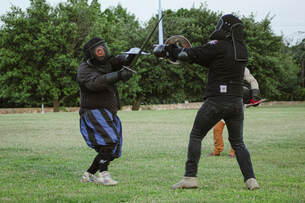|
It is no secret that I enjoy the I.33 manuscript. However, given the barrier in interpreting the art and text and the fact that medieval sword and buckler is not as popular in HEMA, I.33 is a relatively unknown system outside of the primary practitioners of the source. This has led to several HEMA practitioners having misconceptions about I.33. Today, we will dive into the two most common misconceptions about I.33 The first is that the techniques are not martially valid, and the second is that I.33 is an incomplete system. By tackling both misconceptions, I hope to clear some barriers for those interested in studying I.33. Are I.33 Techniques Martially Valid?For many people interested in swordsmanship, the idea that the system they are learning is ineffective can be a significant detractor to keep someone from learning a specific system. Unfortunately, the techniques in I.33 have been seen as techniques that cannot be used for self-defense. This generally seems to be due to I.33’s system looking different than other sword and buckler systems. In Dr. Sydney Anglo’s The Martial Arts of Renaissance Europe, he states in regards to I.33 that “the constrained sword and buckler fighting taught by the priest to his disciple does not look remotely as efficient as the free-flowing, better balanced techniques later expounded by Talhoffer and Marozzo.” When reading I.33, one must look at the manuscript as a collection of techniques the fencer gains when they pair their sword with the buckler. Very few of the I.33 techniques work without the assistance of the buckler. When the buckler is paired with the sword, the fencer can perform longer binding actions and deliver more attacks from the wrist and elbow than with equivalent singlehanded sword systems like Lechuchner’s messer. Talhoffer’s manuscript differs from I.33 by showing how to perform messer attacks and grapples when the buckler is present. Talhoffer first shows techniques that highlight this with just the messer, followed by a section showing the same techniques but with a buckler instead of a bare hand for the displacements. In a way, Talhoffer’s system is more like a sword with buckler than sword and buckler since the off-hand is optional for the techniques. In the context of the Bolognese system, I.33 is a hyper-focus on the concept of the narrow play or “gioco stretto,” where two fencers’ bind their swords, but neither has the advantage. The narrow fight is a minor part of the overall Bolognese sword and buckler system. However, Marozzo (a significant source for the Bolognese sword and buckler system), in chapter 162 of his Opera Nova, states that the fencer who knows both the narrow binding-like plays and the more flowing cuts and thrusts from what I.33 would consider wards, will control the fight. Furthermore, Marozzo taught the narrow plays separately from the wide plays and charged seven pounds for each class. So, even Marozzo sees the validity in the more bind-centric plays that I.33 offers. Is I.33 an Incomplete System? Periodically, commentators on I.33 will state that it is an incomplete system. New sword and buckler fencers looking for a source to study are generally directed towards Bolognese sources because of the inclusion of footwork, sword grips, and other fundamental aspects of swordsmanship. Others have stated that to get the most out of I.33, fencers must draw from other sources to learn swordsmanship fully. However, I.33 does contain enough techniques and a mindset to approach a sword and buckler fight that can make a sword and buckler fencer competent should they have to defend themselves with the weapon. While I agree that the Bolognese sources are more accessible for beginners to learn from, I think the appearance of I.33 being incomplete comes more from comparing it to other systems and noting the differences than it does from the number of techniques in the manuscript. Talhoffer and Bolognese sword and buckler utilize cuts and thrusts without the assistance of the bind. This is notably excluded in I.33. However, from the perspective of I.33, I believe the techniques illustrated and defined are specifically designed to counter the more free-flowing Bolognese and Talhoffer styles. I.33 chooses to siege, a specific position to provoke the opponent out of their starting position. The opponent will either enter the bind, retreat or do nothing. Throughout I.33, those three outcomes of sieging the opponent are discussed. So, while it is accurate to say that I.33 does not include cuts and thrusts from the basic wards like Talhoffer and the Bolognese sources do, it is not accurate to say that the exclusion makes I.33 incomplete. Instead that I.33 chooses to deep-dive into one area of the fight because it values the other style of fighting less. However, it is worth noting that I.33 does have some missing pages, particularly on the use and counters of two wards, fifth and sixth. Fortunately, later sections in the manuscript show how to combat thrusting positions like fifth and sixth, so while the complete set of techniques is incomplete, there still exist enough techniques to counter thrusting wards. Though I believe I.33 is a complete system and can stand on its own, cross-training with other weapons does help HEMA practitioners. My class covers Lechuchner’s messer, I.33, Talhoffer, Paulus Kal, and Lignitzer. All of the fencing masters bring their unique style to the medieval swordfight that benefits a well-rounded sword and buckler practitioner. For more data on cross-training in HEMA, I highly recommend the article on the topic at SwordSTEM. Closing Thoughts I.33 is a unique manuscript that focuses on a series of techniques a fencer can do with the assistance of the buckler. The system focuses on the fight's mindset and choosing to bind and secure the opponent’s weapon before moving in to attack.
However, not all sword and buckler systems approach the fight similarly. The Bolognese sword and buckler system prefers to keep the sword fluid and to move to find openings. Talhoffer similarly will move the sword to close on the opponent while utilizing messer-style attacks. This is the same as other fencing systems like Fiore and Lichtenauer differing. Being different and excluding some techniques other systems include does not make a system incomplete or ineffective. The authors of these sources had to choose what to include and what not to include. So for those that pick up I.33 and think the art style and the Latin text are cool, dive in and start learning about this effective and complete sword and buckler system. You will not regret it.
0 Comments
Leave a Reply. |
Proudly powered by Weebly








